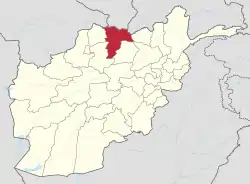Hazrat Ali Mazar
The Hazrat Ali Mazar (Arabic: حضرت علی مزار) is a mosque located in Balkh Province, Afghanistan, that has a tomb attributed to the fourth Islamic caliph, Ali. It is an important pilgrimage site for Shia Muslims, and is also honoured by Sunni Muslims, who pay tribute to Ali's shrine annually. The current mosque is considered a masterpiece of the Timurid Renaissance.
| Hazrat Ali Mazar | |
|---|---|
Rawze-e-Sharif | |
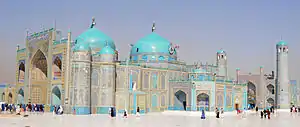 Hazrat Ali Mazar in 2012 | |
| Religion | |
| Affiliation | Islam |
| Branch/tradition | Sunni |
| Province | Balkh Province |
| Festivals | Nowruz |
| Location | |
| Location | Mazar-i-Sharif |
| Country | |
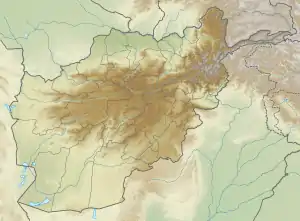 Location within Afghanistan | |
| Geographic coordinates | 36°42′30″N 67°06′40″E |
| Architecture | |
| Type | Mosque |
| Style | Islamic |
| Completed | 1481 |
The site of the mosque is also where many pilgrims celebrate the Iranian/Zoroastrian new year, Nowruz. At the yearly Jahenda Bala ceremony, a holy flag is raised in honour of Ali; Muslim pilgrims often touch the flag for good luck in the coming year.[1][2]
History
Since Ali stated that his body should remain a secret, his followers tied his body on a white camel, and went towards northern Afghanistan.[3] Before being assassinated, Ali had reportedly given instructions to bury his body at the spot where the camel would die. At this location in Balkh, the white camel expired and Ali was buried secretly.[3]
In the 15th century, Abd al-Ghafur Lari is believed to discover Ali's tomb.[4] Identifying the shrine with Hazrat Ali could likely be a myth to ensure the tomb would be protected and honored by the Islamic establishment.[5] The earliest record of Ali being buried in Balkh appears in the Andalusian traveller Abu Hamid's Tuhfat al-Albab, dating to the 12th century. It says that nearly four hundred citizens of al-Khayr had seen in their dreams that Muhammad told that Ali was buried in the village. The Ulama council brought this matter to Balkh's Seljuk ruler Amir Qumaj, who decided to built a large shrine on the burial spot.[6]
The Sultan of the Seljuq dynasty, Ahmed Sanjar, built the first known shrine at this location. It was destroyed or hidden under earthen embankment during the invasion of Genghis Khan around 1220. In the 15th century, Timurid Sultan Husayn Bayqarah Mirza built a mosque over the tomb of Hazrat Ali. It is by far the most important landmark in Mazar-i-Sharif and it is believed that the name of city originates from this shrine.
A site plan of the location made in the 1910s shows that there had earlier been a smaller walled precinct in the mosque, which was razed to create park lands later, although the portals to this precinct still remain as gateways for the shrine.[7]
Tombs of varying dimensions were added for a number of Afghan political and religious leaders over the years, which has led to the development of its current irregular dimensions. These include the square domed tomb of Emir Dost Muhammad Khan, Wazir Akbar Khan and a similar structure for Emir Sher Ali and his family.[7]
Gallery
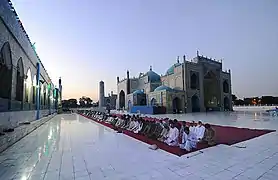 Muslim men praying during the month of Ramadan in 2012.
Muslim men praying during the month of Ramadan in 2012.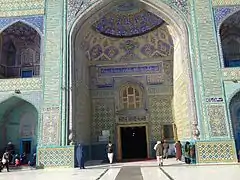 Entrance to one of the buildings.
Entrance to one of the buildings.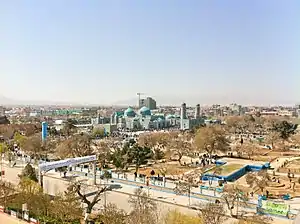 Looking at the mosque from a far distance during the 2011.
Looking at the mosque from a far distance during the 2011.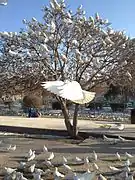 White Pigeons in the courtyard by the Blue Mosque.
White Pigeons in the courtyard by the Blue Mosque.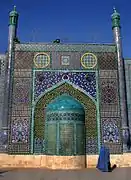 Close up.
Close up.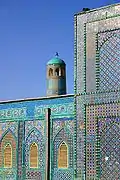 Persian-style tile work.
Persian-style tile work..jpg.webp) A family feeding the pigeons
A family feeding the pigeons
References
| Wikimedia Commons has media related to Blue Mosque, Mazar-i-Sharif. |
- "Janda Bala, flag raising, marked in Balkh". www.pajhwok.com. Retrieved 2020-03-28.
- "Thousands celebrate Nowruz in Mazar-i-Sharif". UNAMA. 2010-03-22. Retrieved 2020-03-28.
- Johnson 2021, p. 327.
- Azad 2013, p. 110.
- Glassé, C. (2003). The New Encyclopedia of Islam.
- McChesney 2014, p. 28.
- "Mazar-e Sharif, Afghanistan". ArchNet. Retrieved 5 May 2014.
Bibliography
- Johnson, Thomas (2021). Historical Dictionary of Afghanistan. Rowman & Littlefield. ISBN 9781538149294.
- McChesney, R. D. (2014). Waqf in Central Asia: Four Hundred Years in the History of a Muslim Shrine, 1480-1889. Princeton University Press. ISBN 9781400861965.
- Azad, Arezou (2013). Sacred Landscape in Medieval Afghanistan: Revisiting the Faḍāʾil-i Balkh. OUP Oxford. ISBN 9780199687053.

